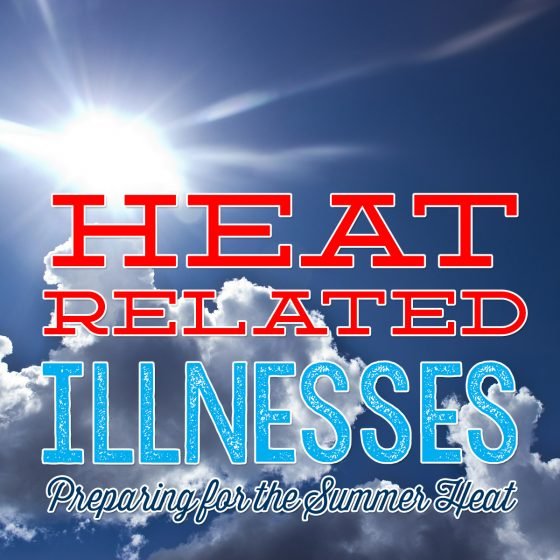The official period of summer for 2017 is from June 21 to September 22. As we approach the summer months, it is important to consider the danger of the heat. If you plan on enjoying the outdoors this summer, you will be at risk of heat related illnesses. Throughout the entire United States, forecasters are predicting above-average temperatures for the summer months, and with this in mind, it is important to take certain precautions when spending time outside.
Exposure to high temperatures in combination with other factors such as high humidity and physical activity can subject an adult or child to heat-related illness.
Heat Cramps
One of the first signs that you are experiencing a heat-related illness may be the onset of heat cramps. These are painful, involuntary spasms that may occur as a result of strenuous activity in a hot environment. Areas most commonly affected include the calves, arms, and abdomen. If you begin to notice your body cramping, it is best to immediately cool down and rest. Additionally, drinking water or a sports drink containing electrolytes will help reduce the cramps. Refrain from resuming vigorous activity for a few hours after the heat cramps have ended to avoid the threat of more severe heat-related illnesses.
Heat Exhaustion
Heat exhaustion is caused by your body’s inability to cool itself. Did you know sweating is your body’s main method of cooling itself? Symptoms of heat exhaustion include weakness, lightheadedness, headaches, dizziness, and fainting. Visually, if you are experiencing heat exhaustion, your complexion may appear pale, your skin may be clammy or moist, and you may be sweating heavily. Internally, you may have an upset stomach and feel some nausea and possibly vomit. Your pulse will feel very strong and be beating rapidly. Furthermore, you may be experiencing some mood changes that you typically wouldn’t think to associate with heat exhaustion including irritability, confusion, and giddiness. If heat exhaustion isn’t treated quickly, it can lead to heatstroke which can be life-threatening.
Heat Stroke
A heatstroke is more serious than heat exhaustion and is caused by your body overheating. Heatstroke is the result of prolonged exposure to high temperatures and has more severe symptoms. Hot, dry skin and a body temperature of 103 and higher are typical. Mental confusion and loss of consciousness may also occur. There is also a possibility of convulsions and seizures. During heatstroke, a person’s body temperature rises so quickly that within 10 to 15 minutes, they could have a temperature of 106 degrees or higher. It is imperative that heatstroke is treated immediately to prevent the possibility of permanent brain damage as well as other vital organs.
Heat Related Illnesses are Preventable
- Stay out of the sun as much as possible. Try to remain in a cool, shaded area.
- Apply sunscreen and wear protective clothing. Wear lightweight, light-colored, and loose-fitting clothing and wear a hat.

- Avoid heavy exercise or working in the heat.
- Take frequent breaks, especially if you begin to notice you are getting a headache, having cramps, or feeling overheated.
- Stay hydrated by drinking plenty of fluids, especially water. Do not wait until you are feeling thirsty to begin consuming fluids.
- Get a personal cup or bottle that goes with you everywhere. Making sure the kids have a sports bottle for their games is very important. (Check out disountmugs.com)
- Avoid alcohol, caffeinated drinks, and heavy meals.
- Rest regularly.
Emergency actions to take if you or someone else falls ill to heat stress
- Move yourself or the victim to a cool area to begin to cool down the body as quickly as possible.
- Soak the victim’s clothing in water to help cool them down.

- Apply cold packs to the victim.
- Use fans or air conditioning.
- Submerge them in a tub of cool water.
- Give the victim fluids. Provide them with cool water and a drink that has electrolytes such as Gatorade.
- Call 911 if you are unable to restore the body to its normal temperature and condition.
It’s going to be a hot summer, but the outside is calling your name! No one wants to stay indoors all summer long, so let’s ensure that we take the proper precautions before an extended period of time in the sun and heat and enjoy nature responsibly.
Sources: Heat Exhaustion, Warm May Ahead for Northern Tier of the Nation, Heat Stress-Heat Related Illness
Photo credits: Sasha Staton, Pixabay










































